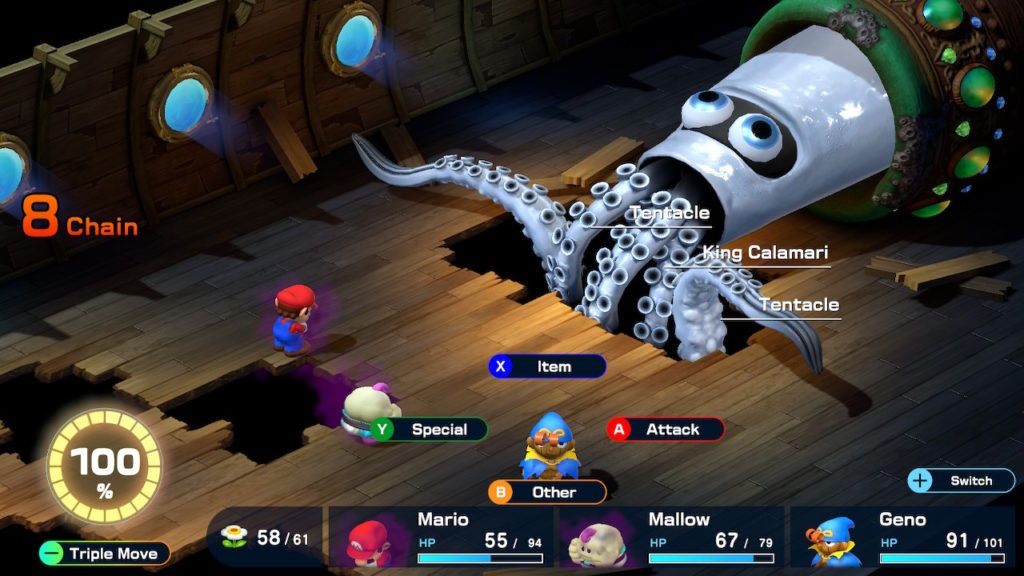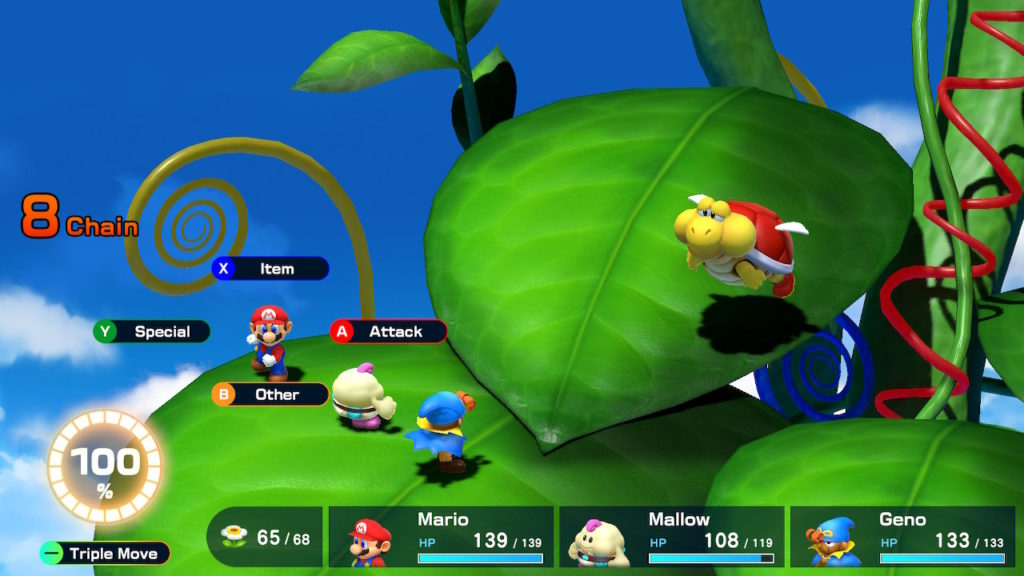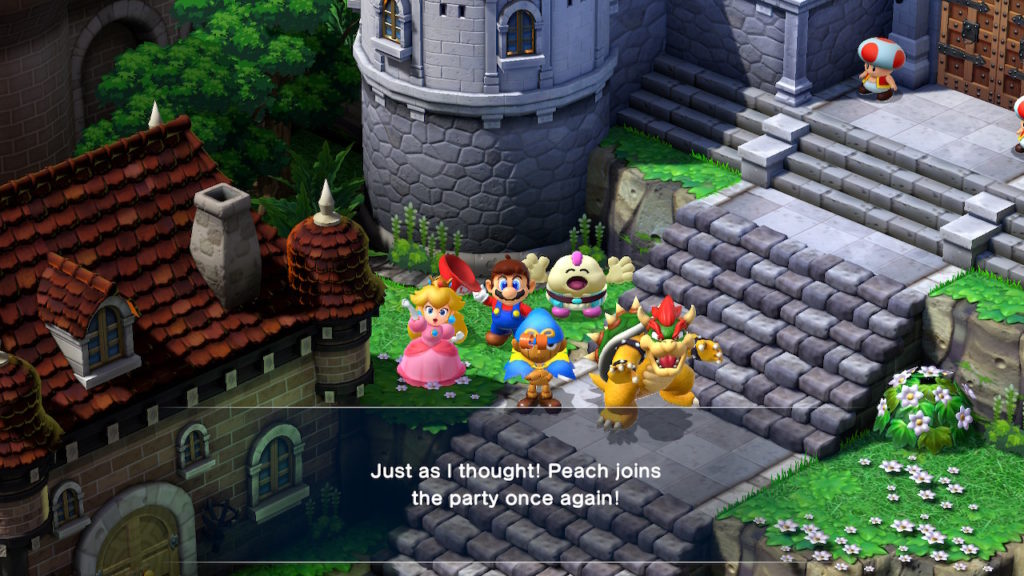- Genre: JRPG
- Platform: Switch
- Originally Available On: SNES, Virtual Console, SNES Classic
It’s a bit surprising that I’m doing back to back remakes of old games that came out in the late 90s, but here we are. Where Pharaoh felt like it strayed too close to the original and could have benefited from more modernization, Super Mario RPG feels like it does a good job of maintaining what worked in the original and smoothing out some things for a modern audience while also adding a couple new features here and there that maybe don’t work as well.

I guess we’ll start out with combat, since it’s where most of the changes occurred that stood out in my head. In this case, I’ll start with the two things that didn’t necessarily work out well for me.
The first is the little meter in the bottom left corner of that screenshot. This is one of the new mechanics tied to action buttons, where you can get bonus offensive or defensive boosts if you time an A button press based on the action occurring. In this case, the meter builds up when you get good action buttons until you hit 100%. At that point you can activate a move based on the composition of your team, with each team combo having some different move. The problem I have with these is that situationally they can be very useful in a niche, but aren’t generally that useful in most cases.
For example, one of the moves heals all party members both on and off the field. It’s useful if you got nuked by a big boss move, but you’d have to have the right party combo (Mario/Peach/Mallow) be alive to activate it anyway. The big offensive combo of Mario/Bowser/Geno does a series of random attacks and buffs which can be useful in the start of a boss battle to buff your party, but it requires your healers to then skip out on the buffs. It then takes a fair number of turns to recharge the meter so often I’d be sitting there holding onto it considering whether it’s worth using only to then finish the fights anyway. It’s one of those ideas that on paper sounds good, but in practice falls to a lot of the classic JRPG problem of holding onto something for so long that you lose the chance to use it.
Another thing that didn’t work out as well for me was the inclusion of randomized special enemies. These are nice in one respect in that they drop frog coins, which makes collecting them much easier than in the original game. However, the special enemies have weird mechanics (ex: nearly immune to physical damage, faster move speed, etc) and very little other over the top reward, so it again feels like a case where the idea is good on paper but not really baked enough to be a fun feature.

However, new things are much more positive for me from there. There are three small changes tied to the action button mechanic that all end up summing up to a much greater whole for the feature.
The first is the inclusion of a little (!) symbol to teach you the timing. This will show up the first handful of times you have to hit the action on a new move, both offensively and defensively. It allows you to learn the timing on the fly without the guess work of the original game. The nice thing is that once you get the timing right a few times, it goes away. However, if you later start to then miss the timing consistently it will come back until you learn the timing again. This is a fantastic way to teach players quickly about new moves, while allowing timing to be wildly different for different types of attacks. It also removes the feeling of being hand holdy by going away and letting the player succeed through repetition or fail for a while before it comes back.
The second is that successful action button attacks now change the damage to be AoE, doing about 25% damage to all non-targeted NPCs in the attack. My initial instinct was that this was going to make the game much easier, and it certainly does. However, where that ease comes in is just making trash fights much quicker. Now if I’m not quite one-shotting enemies, I can still just move on and attack other NPCs. More often than not, I would be able to clear a normal 3-person trash fight in 3 attacks by simply focusing each target once and letting the AoE take over. It’s ultimately a huge time saving reward for getting your action timing right, and not something that necessarily is negatively impacting difficulty.

The third is the chain mechanic. Getting action button timing right will build up the chain, providing stacking buffs to the entire party. Each party member then has stats tied to them that apply to this. For example, Mallow increases magic attack while Geno increases physical attack and speed. What this allows you to do as the player is to mix and match your party for the situation beyond just what moves the member does. It’s again something that has the effect of making the game easier on paper, but also providing a strong incentive towards hitting your timing just right. This becomes incredibly important in the post-game when the player is fighting boss rematches on the way to fighting the ultimate form of Culex.
The final thing that I want to point out is how much better inventory management is. Rather than being a fixed list of 20 or so items that you can carry, you can now carry infinite items but with a limit per item type. For example, you can carry 10 mushrooms total or 6 pick me ups total. Anything over that amount is sent back to storage at Mario’s house. This just gets rid of so much hassle from the original game. You’re no longer keeping an empty slot just to pick up flower tabs. You’re no longer fighting with whether a revive is more important than a syrup. You’re no longer scrolling through the long unwieldy list for one specific thing. It’s such a small change but it modernizes the game incredibly well.
This is very clearly a lovingly crafted remake. It maintains the wonderful gameplay of the original game, completely revamps the visuals (because hoooooo boy the 2D didn’t age well on non-CRTs), reorchestrates the wonderful soundtrack, and does just enough to play the balance between nostalgia and modernization. It shows why the original game was so well received 25+ years ago and manages to still feel like a great experience now.

One Reply to “How’d It Age #7 – Super Mario RPG”
Comments are closed.